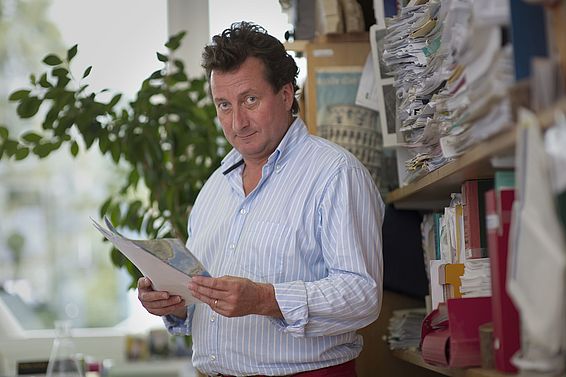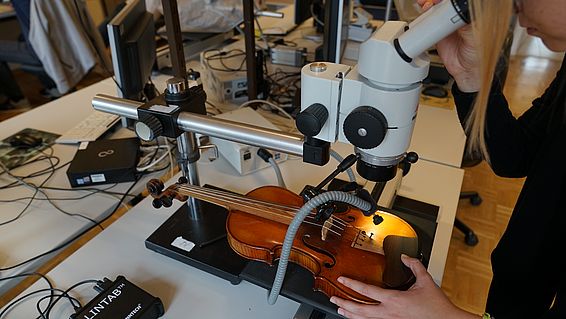24.9.2021 | Stephanie Kusma| News WSL
Is it an authentic Stradivarius or not? The answer to this question can dramatically affect an instrument's value. Dendrochronologists such as Paolo Cherubini from the Swiss Federal Institute for Forest, Snow and Landscape Research (WSL) help to uncover the truth. In the academic journal Science he describes how they do so.
How did you get involved with musical instruments?
Years ago, I was asked to testify as an expert in a court case centring on the age of a valuable viola, supposedly made in the 16th century by Gasparo da Salò. A violinist had bought it for over €200,000, but he then started to suspect its authenticity and so had it verified by two laboratories that specialised in determining the age of objects by analysing tree rings. Both concluded that the wood used to make the viola dated from the 17th century. As Gasparo died in 1609, this meant that the viola was produced after his death, which slashed its value to around a tenth of what it would otherwise have been. At that time, I was asked by the victim's lawyer to testify as an expert and explain the methodology to the court. That's how I got into the dendrochronological dating of musical instruments.
How does the method work?
The tree rings of the wood used to make a stringed instrument are analysed. This is done by measuring their width, either on the instrument itself or using photographs. The best place to do this is on the top of the instrument. You can also examine the wood in a computer tomograph or MRI scanner or analyse the images using computer programs.
What happens next?
The ring sequence on the instrument is then compared (or cross-dated) with previously dated series of rings from trees. It is important that the trees originate in the same region as the wood used for the instrument. Another possibility is to compare it with instruments whose makers are known for certain. Having said that, you always need a reference tree-ring series.
So do we know where the leading violin makers sourced their wood?
There you've hit upon a weakness in the methodology. In many cases, all we have to go on are legends, tales and myths. In the Paneveggio Forest in Italy, for example, people say that Antonio Stradivari personally selected the wood for his instruments in the Fiemme Valley by listening to the noise made by felled trees as they slid downhill – a story I first heard back when I was doing research there for my PhD thesis. However, this hasn't been confirmed. It would be interesting to research this in the archives, for example by looking for invoices for wood supplied to instrument makers – but no one has done this yet.
What happens if you don't know where the wood came from?
There are public databases containing tree-ring series, for example the International Tree Ring Database administered by the US National Oceanic and Atmospheric Administration (NOAA) in Colorado. But not many chronologies go back 500 years and come from the right areas. We need new, public chronologies, compiled, for example, from living trees and wooden beams forming part of old houses. All the same, researchers have managed to determine the origin of the wood used in instruments. For example, it has been found that many of the old violin makers from northern Italy used wood from the Fiemme Valley.
Is it possible to date all wooden instruments in that way?
No, because there must be enough rings. You need at least 50, 60 or 70 rings to be able to give a statistically robust assessment of the instrument's age. As a result, this is easier to do with a double bass than with a cello, and easier with a cello than with a viola, and so on. The front or back of a violin usually has just about enough rings for this purpose, but for wooden instruments that are too small, it isn't possible.
How accurate is this calculation of the age?
The year can be determined in which the last tree ring you can see on the instrument was formed. This is known as the terminus post quem (Latin for "limit after which") and indicates that the instrument can't have been made before that time. So it must have been after that, but it's impossible to say exactly when, as the wood may have been stored for years, or sections of the wood used to make the instrument may have had more recent tree rings but were discarded during construction. Sometimes, too, violin makers reused very old wood. Still, what is clear is that if Gasparo da Salò was plying his trade in the 16th century and a tree was still growing in the 17th century, its wood can't have been used to make a Gasparo da Salò violin.
Have other counterfeits been identified in this way?
Yes. Peter Klein (based in Hamburg), for example, who helped to refine the method in its early days, unmasked a number of instruments that had been attributed to the wrong violin makers. That doesn't mean they were necessarily counterfeits, because in the 18th century, many violin makers tried to imitate Stradivari's instruments to match their tonal quality. Nowadays this can give rise to confusion because instruments look as if they were made by Stradivari when they weren't.
Why is this type of dating needed?
It's the only technique that doesn't involve having to destroy at least a tiny part of the instrument and yet reveals a key date, in the form of the terminus post quem. It would be interesting, for example, to search for genetic material in the wood of instruments and so obtain information about the origin of the timber. However, such analyses require wood shavings, and no one wants to scratch a Stradivarius. Sometimes such fragments are shed during restoration work, and so that would perhaps be one possibility.
Paolo Cherubini researches the dendrochronological dating of wood at the Swiss Federal Research Institute WSL. In the academic journal Science he describes how his field of research interfaces with the work of leading 16th‑century violin makers.
Contact
Links
- Tree ring research at WSL
- Science Insights: Tree-ring dating of musical instruments
Publications
Copyright
WSL and SLF provide the artwork for imaging of press articles relating to this media release for free. Transferring and saving the images in image databases and saving of images by third parties is not allowed.

